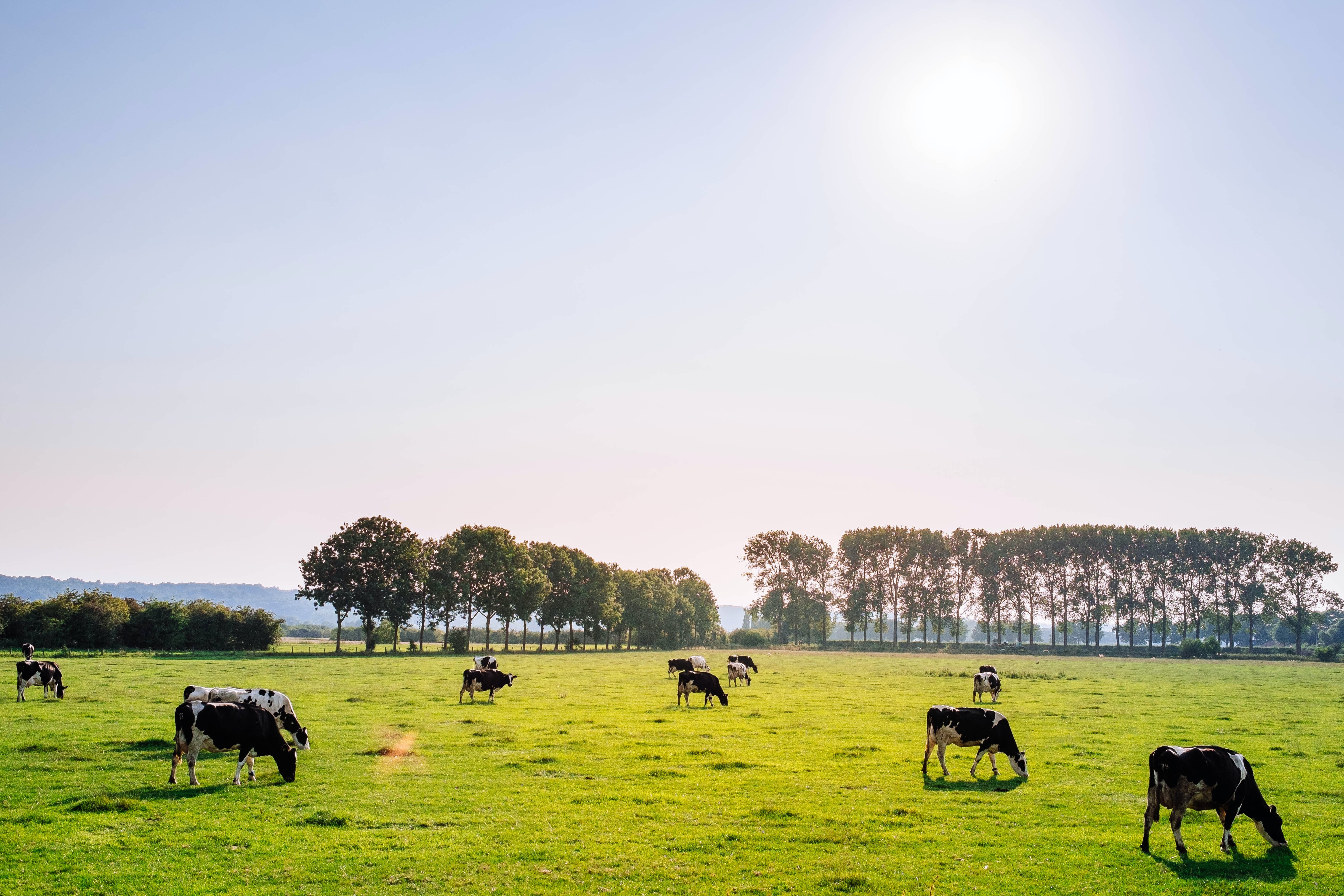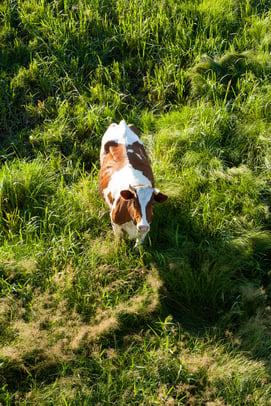Is Grass-Fed Milk Better?
The milk section of the supermarket has never been so crowded. Browse the shelves and you’ll find milk made from oats, almonds, rice, soy, and even pea.
Alongside plant-based milk, cow’s milk is — of course — still on offer. But it’s now available in more varieties, not just the whole fat, 1%, and yummy chocolate flavor versions we all know so well.
Nowadays, we can choose between conventional cow’s milk, organic cow’s milk, grass-fed cow’s milk, and 100% grass-fed cow’s milk.
For anything but conventional cow’s milk you’ll pay a premium. But are the more expensive options worth the money? And what do those labels actually mean?
Does grass-fed milk taste better? Is it better for the cows? Is it good for your health — and that of the environment?
Here we answer all of those questions, helping you to make the right milk choices for you and your family.
 What is grass-fed milk?
What is grass-fed milk?
Grass-fed milk comes from grass-fed cows. But how much grass does a cow have to actually eat for its milk to fall into the grass-fed category?
Traditional grain-fed milk
All cows eat some grass. But conventional cows also eat a lot of grain, like corn, barley, oats, or soy.
A cow wouldn’t naturally choose to eat grain. It would happily munch away on grass for breakfast, lunch, and dinner. However, a grain-based diet provides benefits for farmers.
Grain is higher in calories than grass, which means grain-fed cows put on weight faster (great for beef farmers) and produce more milk (great for dairy farmers).
Grass-fed milk
So how does grass-fed milk differ from traditional cow’s milk?
Grass-fed cows have access to pasture, which means they can roam and forage for their food, as they would do under natural conditions.
They satisfy most of their dietary needs with grass, veggies (like legumes and brassicas), young plant shoots, twigs, and cereals (but only in their pre-processed, plant state).
Grass-fed cows may eat some grain, but it doesn’t make up the majority of their diet.
100% grass-fed milk
If you spot a label for 100% grass-fed milk, it means that the cows involved in its production were solely chowing down on the good old green stuff — no grain supplements at all.
But…there’s a problem for consumers.
Grass-fed milk certification
There’s very little regulation around grass-fed labeling.
This means it’s difficult for consumers to know for sure what proportion of each year a cow spends outdoors, foraging for its food.
To reassure consumers, some dairy brands have chosen to partner with third-party grass-fed regulators, like A Greener World and the American Grassfed Association (AGA).

These organizations have a list of standards that dairy farmers have to meet before they get grass-fed certification and the associated label on their packaging.
Annoyingly, standards may vary from one organization to another. So to be totally confident in the milk product you’re buying, it’s worth researching the standards behind the certification.
That way you know exactly what kind of life and diet the cows involved in a milk’s production enjoyed.
Is organic milk grass-fed?
The quick answer? Kind of.
Milk with the USDA Organic label has met a couple of key production standards.
- Cows haven’t been given growth hormones or antibiotics
- Cows are fed organic grain
- Cows live in healthy indoor spaces and have access to fresh air, sunlight, and exercise areas all year round
- Cows graze on pasture for a minimum of 120 days per year and get at least 30% of their dietary intake from grass
So organic milk comes from cows that eat some grass. But the cows that produce properly certified grass-fed and 100% grass-fed milk spend more time outdoors eating their natural diet.
You’d want to see both an organic and a grass-fed label on a carton of milk to be convinced that it was ticking all of the boxes.
Is grass-fed milk better for health?
There are lots of nutritional similarities between grain-fed and grass-fed milk. They have a similar calorie and fat content. They also provide similar levels of protein, carbohydrate, and calcium.
However, research has shown that grass-fed milk is higher in a couple of important nutrients.

Grass-fed milk is higher in omega-3 fatty acids — essential for brain and eye health, and really important for growing children. We can only get omega-3 fatty acids from the food we eat.
Grass-fed milk is also higher in conjugated linoleic acid (CLA). Studies have shown that CLA can help to prevent obesity and some cancers.
Grass-fed milk is higher in vitamin E, which supports healthy skin, eyes, and a strong immune system.
Grass-fed milk is higher in iron. Iron is used by the body to make red blood cells. Low levels can cause tiredness and anemia.
Is grass-fed milk better for the environment?
This is a complicated one. There are environmental pros and cons associated with grass-fed milk.
The good
Grass-fed cows contribute to a healthy ecosystem and regenerative agriculture methods.
As cows graze, their manure returns nutrients to the soil. This helps to improve soil microbial diversity and even makes the land more resistant to extreme weather events like flooding and drought.
Manure-enriched soil produces plants with better nutrient content, while the grasses in pasture land also help to store carbon (keeping it out of the atmosphere).
The bad
Grazing cows require more pasture space than grain-fed cows. If demand for grass-fed meat and dairy products increases, this could lead to an increase in deforestation and biodiversity loss.
The ugly
Grass-fed cows generally live longer lives than grain-fed cows, which means they produce more methane over the course of their lives.
The upshot?
Working out the environmental impact of grass-fed vs grain-fed dairy farming is a tough one.
According to this study, grass-fed dairy farming is better for the environment — it uses less energy, less water, and produces less greenhouse gas.
But because grass-fed cows produce less milk greenhouse gasses per unit of milk were actually greater for grass-fed milk production.
Does grass-fed milk taste better?
The food an animal eats affects the taste of its meat and milk. Studies suggest that grass-fed cows produce creamier and more flavorsome milk and cheese.
But taste is obviously very subjective.
The easiest way to answer this question? Do your own taste test to see whether grass-fed milk really has a superior flavor.
Is grass-fed milk better for cows?
A lot of factors come into play when we consider animal welfare.
What are the cows’ living conditions? Are they given high-quality veterinary care? How and when are they slaughtered when their milk production drops?
Diet definitely forms part of that picture.
Grass is what a cow would naturally choose to eat, so its four-chambered stomach has evolved to process it efficiently.
Grain, on the other hand, is a little trickier for cows to digest. A grain-based diet can lead to a build-up of acid in the cow’s stomach. This can cause a condition called acidosis, the symptoms of which include lethargy, increased heart rate, and diarrhea.
Acute acidosis can even lead to death.
Get more of the latest food insight
Want to find healthy foods that are good for you and the environment?
Visit the Buffalo Market blog for the latest insight around food and drink products — and their production. Or start by taking a look at some of our most recent articles:
- Summer: What Foods are in Season?
- The Best Foods to Help You Lose Weight
- Greek Yogurt and Regular Yogurt: What’s the Difference?
- What’s the Difference Between Carbon Neutral and Carbon Negative?
- Why Grapefruit Is One of the World’s Healthiest Foods

